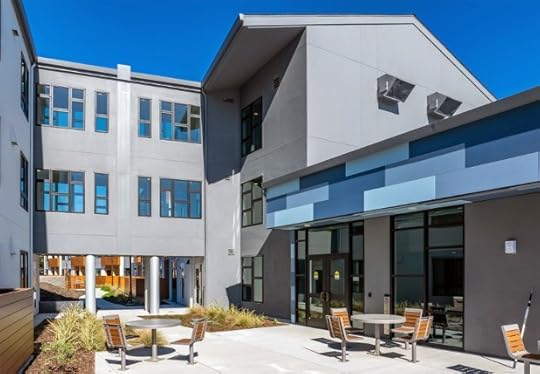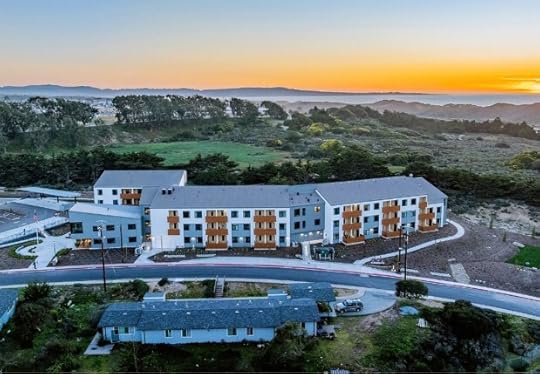Veterans Transition Center’s Lightfighter Village in Marina complete
MARINA – Years in the making, Lightfighter Village in Marina has been completed, marking a milestone for the Veterans Transition Center in creating a place homeless veterans will be able to live in perpetuity, with no transitional requirements, while they continue to receive case management and access to support services.
Kurt Schake, CEO of the Veterans Transition Center, the nonprofit organization that has been serving homeless veterans and their families since 1998, said his organization is “elated” about the completion of the project.
“We now have the ability to serve more veterans,” said Schake, who added that with seven different VTC housing programs, there are now 184 beds for veterans.
Lightfighter Village is a 100% affordable, the three-story, 71-unit housing structure on 2.3 acres situated on Hayes Circle in Marina that was approved by the city of Marina in November 2018 and has been planned for about a decade.
The Lightfighter Village project is a partnership between the Veterans Transition Center and EAH Housing Inc.
“The completion of Lightfighter Village is a proud and meaningful moment for EAH Housing,” said Chief Real Estate Officer at EAH Housing Welton Jordan. “This community isn’t just about providing housing, it’s about honoring our veterans with the stability, dignity and support they deserve.”
Schake said the first tenants started to move into the 70 units this month with one unit reserved for the manager of the complex.
According to EAH Housing, it is actively leasing up the property now and planning a grand opening for fall in conjunction with Veterans Day.
“Seeing residents move in and begin rebuilding their lives makes all the hard work worthwhile. This project’s success is a testament to the power of collaboration, made possible by our partnership with the Veterans Transition Center and the support of local, state and federal leaders,” said Jordan. “Lightfighter Village proves that when we come together with a shared mission, we can create real, lasting change for those who served our country.”
Jordan said in an earlier report that since 2015, EAH Housing has worked in partnership with the city of Marina and the Veterans Transition Center of California to bring much needed affordable veteran housing to Monterey County.
“As the general contractor on this meaningful project, we had the privilege of helping bring this vision to life – constructing a supportive, high-quality community featuring studio and family apartments along with amenities such as a fitness room, computer lab, meditation space, pet wash station and more,” said Huff Construction Company earlier this week in a post on social media.
Huff Construction went on to say thank you to its client, EAH Housing, and co-developer, the Veterans Transition Center of California, for trusting Huff Construction Company, Inc. to build Lightfighter Village.
“We’re honored to contribute to a community that gives back to those who have served.,” said Huff Construction.
 The Lightfighter Village is a 100% affordable housing project, and was approved by the city of Marina in November 2018. The project is something that has been planned for about a decade and will increase the Veterans Transition Center’s on-site housing stock. (EAH Housing)
The Lightfighter Village is a 100% affordable housing project, and was approved by the city of Marina in November 2018. The project is something that has been planned for about a decade and will increase the Veterans Transition Center’s on-site housing stock. (EAH Housing)Lightfighter Village is within a half-mile of transit, employment, shopping and the Veterans Affairs/Department of Defense outpatient clinic as well as the Veterans Transition Center headquarters at Martinez Hall on what was once the Fort Ord Army base. The military installation was shuttered under the Base Realignment and Closure Act of Congress in 1994. Land from the closed Army base was conveyed to the cities of Marina, Seaside, Monterey, Del Rey Oaks and the County of Monterey.
Lightfighter Village was fully funded for about $50 million from a number of sources including National Equity Fund/Local Initiatives Support Corporation Grant, Monterey County — No Place Like Home California Department of Housing Community Development, No Place Like Home Capitalized Operating Subsidy Reserve, California Housing Accelerator Tier 2, Veterans Housing and Homelessness Prevention Program, HUD Sec 811 Capital Grant and Federal Home Loan Bank — and San Francisco Affordable Housing Program.
EAH Housing is a nonprofit corporation which develops, manages and operates affordable housing for low-income families, older adults and persons with disabilities, special needs or both, in California and Hawaii. It was founded in 1968.
EAH Property Management operates all properties in the EAH development portfolio and will be managing Lightfighter Village.
Of the total number of units, 64 will be studio apartments at roughly 415 square feet, and seven two-bedroom units of about 850 square feet, including one manager’s unit. Each unit features energy-efficient appliances, window coverings and walk-in closets. The structure will include a community room, garden, bike parking, on-site parking, manager’s office, computer lab, a pet wash station, laundry facility, meditation room, fitness room and resident lounges.
 Lightfighter Village is situated on Hayes Circle, within a half-mile of transit, employment, shopping and the Veterans Affairs/Department of Defense outpatient clinic as well as the Veterans Transition Center headquarters at Martinez Hall on what was once the Fort Ord Army base. (EAH Housing)
Lightfighter Village is situated on Hayes Circle, within a half-mile of transit, employment, shopping and the Veterans Affairs/Department of Defense outpatient clinic as well as the Veterans Transition Center headquarters at Martinez Hall on what was once the Fort Ord Army base. (EAH Housing)Lightfighter Village is pursuing GreenPoint Gold certification, showcasing a strong dedication to sustainability and environmentally friendly practices, according to EAH Housing. It is one of three EAH affordable housing developments in Monterey County.
Lightfighter Village is named after the 7th Infantry Division of the U.S. Army that was primarily based at Fort Ord and would be part of the 10 acres of land the Veterans Transition Center uses for its operations including its emergency, transitional permanent housing programs and other services for veterans.
Schake said that over the past 12 months the Veterans Transition Center’s housing programs are at 92% occupancy.
By the end of April, Schake said, the number of beds available in the VTC’s housing programs will increase by eight to 192 beds when two accessory dwelling units are built on property nearby to Lightfighter Village. The ADUs are made possible with seed money from the RW Family Foundation ($150,000), matching funds from the VTC for $150,000, and a state grant through the County of Monterey for $382,000. Infrastructure is currently being placed before the ADUs can be located at the site with the $682,000 ADU project expected to be occupied by late May.



